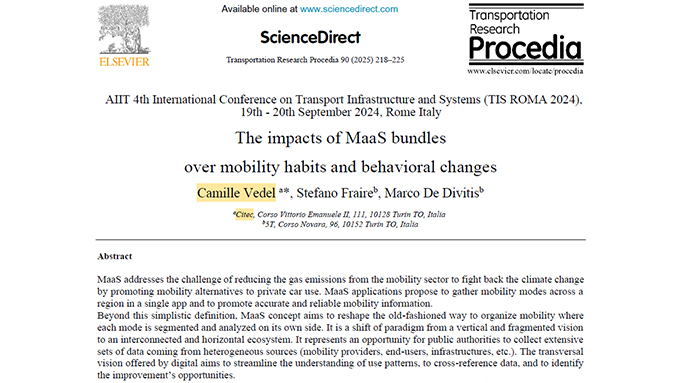Author:
Camille Vedel
At the AIIT 4th International Conference TIS Roma, Camille Vedel, Digital Innovation Project Manager at Citec, presented findings from a scientific paper co-authored with 5T and published in Transportation Research Procedia. It explores the impact of MaaS bundles on mobility habits, based on trials conducted in Turin. The study investigates how MaaS can encourage shifts away from private car use and support climate goals by promoting sustainable mobility alternatives.
MaaS addresses the challenge of reducing the gas emissions from the mobility sector to fight back the climate change by promoting mobility alternatives to private car use. MaaS applications propose to gather mobility modes across a region in a single app and to promote accurate and reliable mobility information. Beyond this simplistic definition, MaaS concept aims to reshape the old-fashioned way to organize mobility where each mode is segmented and analyzed on its own side. It is a shift of paradigm from a vertical and fragmented vision to an interconnected and horizontal ecosystem. It represents an opportunity for public authorities to collect extensive sets of data coming from heterogeneous sources (mobility providers, end-users, infrastructures, etc.). The transversal vision offered by digital aims to streamline the understanding of use patterns, to cross-reference data, and to identify the improvement’s opportunities. The next step towards an integrated MaaS approach is to break down the vertical organization for payment and access. This abstract presents the experiment ‘Mobility Vouchers’, led by the City of Turin and in collaboration with 5T S.r.l., which aimed to test the most evolved version of the “Mobility as a Service” (MaaS) (4th level). The experiment was conducted at a local level in the urban area of Turin and with “real” users. The real innovation of this experiment lays in testing the app in real conditions for the first time in an Italian city. This published paper seeks to challenge the prevailing assumption and to investigate whether facilitating the booking and payment of multiple modes through a fully integrated workflow, coupled with customized fare structures, could foster a greater inclination towards multimodal transportation among users.


